Star villages of the Vale of White Horse
Star villages are my favourite villages. I recommend them because I think they are amongst the most attractive in the Vale, or they have interesting features that makes a visit really worthwhile.
1 Ashbury
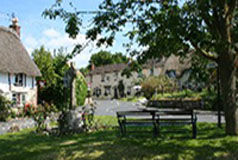 Ashbury is a small, pretty, village at the foot of the
Berkshire Downs on the B4000, the road that links Lambourn,
the racehorse capital of the downs, with the Vale village
of Shrivenham. The village has an attractive blend of chalk and
stone cottages, many of them thatched. In the centre is
a small triangular green with a well-kept war memorial
and a thoughtfully placed seat. Ashbury is a small, pretty, village at the foot of the
Berkshire Downs on the B4000, the road that links Lambourn,
the racehorse capital of the downs, with the Vale village
of Shrivenham. The village has an attractive blend of chalk and
stone cottages, many of them thatched. In the centre is
a small triangular green with a well-kept war memorial
and a thoughtfully placed seat.
|
2 Baulking
 The tiny village of Baulking
is about a mile north-east of Uffington and a couple of
miles south-west of Stanford in the Vale. To visit Baulking is like stepping back in time! All that
is missing are the geese that should be on the green and
the horses that should be working the fields. Here there
are no modern houses, no modern restaurants posing as
the village pub, no unsightly cars and vans, just a lovely
old church, a quiet goose green, a few unpretentious cottages
that at first sight appear entirely unmodernised, and
several farms. The tiny village of Baulking
is about a mile north-east of Uffington and a couple of
miles south-west of Stanford in the Vale. To visit Baulking is like stepping back in time! All that
is missing are the geese that should be on the green and
the horses that should be working the fields. Here there
are no modern houses, no modern restaurants posing as
the village pub, no unsightly cars and vans, just a lovely
old church, a quiet goose green, a few unpretentious cottages
that at first sight appear entirely unmodernised, and
several farms.
|
3 Blewbury
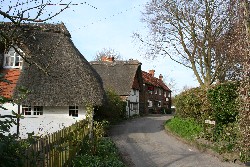 Blewbury is a large spring-line village at the foot of the Berkshire Downs. The A417 skirts along the edge of the village and has some interesting and attractive houses, a small green with the remains of the village stocks, and gives a good impression of the village, but the real attractions are away from the main road. Turn down Westbrook Street, South Street, or the attractively named Nottingham Fee and you are in a different world. Look for the parish church and almshouses, the thatched cobb walls or the unexpected lake and explore the maze of footpaths. Blewbury is a large spring-line village at the foot of the Berkshire Downs. The A417 skirts along the edge of the village and has some interesting and attractive houses, a small green with the remains of the village stocks, and gives a good impression of the village, but the real attractions are away from the main road. Turn down Westbrook Street, South Street, or the attractively named Nottingham Fee and you are in a different world. Look for the parish church and almshouses, the thatched cobb walls or the unexpected lake and explore the maze of footpaths.
|
4 Buscot
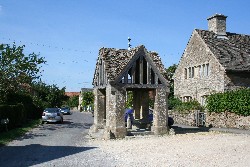 Buscot is an attractive little village on the A417 Faringdon
to Lechlade road about 2 miles from Lechlade, and is
the last village along this road before you cross into
Gloucestershire. Buscot village belongs to the National Trust and is a must-see if you are visiting the nearby National Trust property at Buscot Park. Stroll through the village to Buscot lock and maybe walk along the footpath to the parish church which is about a quarter of a mile from the lock. Buscot is an attractive little village on the A417 Faringdon
to Lechlade road about 2 miles from Lechlade, and is
the last village along this road before you cross into
Gloucestershire. Buscot village belongs to the National Trust and is a must-see if you are visiting the nearby National Trust property at Buscot Park. Stroll through the village to Buscot lock and maybe walk along the footpath to the parish church which is about a quarter of a mile from the lock.
|
5 Childrey
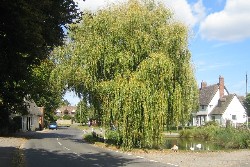 Childrey is an attractive springline village nestling
at the foot of the Berkshire Downs right on the edge of
the Vale of White Horse. Approaching the village on a
fine day from Wantage about three miles away east along
the B4507, the setting appears perfect with the hills
on one side and the Vale on the other. Wonderful!
In the centre of the village is an attractive duck pond, complete with
ducks and geese, attractive cottages and the village shop
and pub. Childrey is an attractive springline village nestling
at the foot of the Berkshire Downs right on the edge of
the Vale of White Horse. Approaching the village on a
fine day from Wantage about three miles away east along
the B4507, the setting appears perfect with the hills
on one side and the Vale on the other. Wonderful!
In the centre of the village is an attractive duck pond, complete with
ducks and geese, attractive cottages and the village shop
and pub.
|
6 Goosey
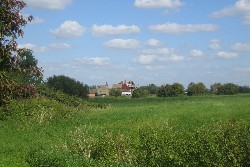 Goosey
is a small village about two miles south east of Stanford in the Vale
on a minor road to the east of the A417. The village consists of a few houses, cottages and
farm buildings scattered around a very large green, rather like the nearby village of Baulking. Peace and solitude! Goosey
is a small village about two miles south east of Stanford in the Vale
on a minor road to the east of the A417. The village consists of a few houses, cottages and
farm buildings scattered around a very large green, rather like the nearby village of Baulking. Peace and solitude!
|
7 Great Coxwell
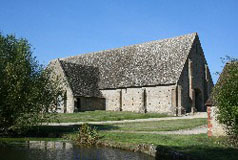 Great
Coxwell is a small and unremarkable village on high ground about 2 miles south west of Faringdon, just
off the A420 Oxford to Swindon road. However just
outside the village is the Great
Coxwell Barn which was completed in the middle of
the 13th century. It is the finest surviving medieval
barn in the country and is now owned by the National Trust.
This is an impressive 152 feet long Cotswold stone barn
with Cotswold stone tiles supported by oak posts which
sit on top of 22 feet high stone posts. Great
Coxwell is a small and unremarkable village on high ground about 2 miles south west of Faringdon, just
off the A420 Oxford to Swindon road. However just
outside the village is the Great
Coxwell Barn which was completed in the middle of
the 13th century. It is the finest surviving medieval
barn in the country and is now owned by the National Trust.
This is an impressive 152 feet long Cotswold stone barn
with Cotswold stone tiles supported by oak posts which
sit on top of 22 feet high stone posts.
|
8 Letcombe Bassett
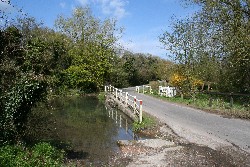 Letcombe
Bassett is a pretty little village, arranged above a steep-sided
valley that is the source of the Letcombe Brook. Although not on the high downs,
when approaching Letcombe Bassett from Childrey about three miles to the north,it is apparent that this
is a proper downland village, unlike others nearby which follow the spring line lower down. In the
springtime roadside verges in the village are pretty with
snowdrops and daffodils. Letcombe
Bassett is a pretty little village, arranged above a steep-sided
valley that is the source of the Letcombe Brook. Although not on the high downs,
when approaching Letcombe Bassett from Childrey about three miles to the north,it is apparent that this
is a proper downland village, unlike others nearby which follow the spring line lower down. In the
springtime roadside verges in the village are pretty with
snowdrops and daffodils.
Approaching
from Letcombe Regis, the road follows the
route of the Letcombe Brook, but at a higher level and, as
the road enters the village, it drops to cross the brook
at the watercress beds where the old ford is still clearly
visible. A bench has thoughtfully been provided here to
enable visitors to relax and admire the peaceful scene.
Watercress was once a thriving industry as local springs
provide the pure water it needs for successful cultivation.
Bassett Cress was sold as far away as Covent Garden. |
9 Stanford in the Vale
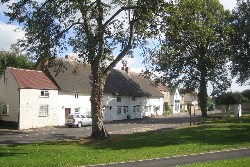 Stanford
in the Vale is an attractive large village in the centre of the Vale of White Horse about four
miles from Faringdon and six from Wantage. In
the centre of the village is an attractive village green
with the Church of St. Denys on the western edge and picturesque
old cottages, the manor house and one of the village pubs
on the others. Well worth a visit! Stanford
in the Vale is an attractive large village in the centre of the Vale of White Horse about four
miles from Faringdon and six from Wantage. In
the centre of the village is an attractive village green
with the Church of St. Denys on the western edge and picturesque
old cottages, the manor house and one of the village pubs
on the others. Well worth a visit!
|
10 Sutton Courtenay
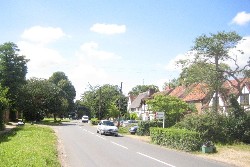 Sutton
Courtenay is a largish straggling village on the south
side of the River Thames about 3 miles north east of Didcot. In the centre of the village is the Manor House which, together with the house now known as
Norman Hall, is on the site of a former Royal palace. On the other side of the road is a building now known as 'The Abbey'. This was the Rectory
House and was built in the 13th century incorporating
some of an earlier dilapidated Parsonage that had been
used as a Grange for Abingdon Abbey. Sutton
Courtenay is a largish straggling village on the south
side of the River Thames about 3 miles north east of Didcot. In the centre of the village is the Manor House which, together with the house now known as
Norman Hall, is on the site of a former Royal palace. On the other side of the road is a building now known as 'The Abbey'. This was the Rectory
House and was built in the 13th century incorporating
some of an earlier dilapidated Parsonage that had been
used as a Grange for Abingdon Abbey.
|
11 Uffington
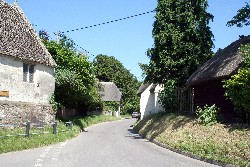 Uffington is about a mile and a half north
of the B4507 Wantage to Ashbury road close to the villages
of Woolstone and Kingston
Lisle, just south of the Berkshire Downs. Most
people probably associate the name 'Uffington' with the
famous White
Horse which was cu Uffington is about a mile and a half north
of the B4507 Wantage to Ashbury road close to the villages
of Woolstone and Kingston
Lisle, just south of the Berkshire Downs. Most
people probably associate the name 'Uffington' with the
famous White
Horse which was cu t
into the hillside of the Berkshire Downs above the nearby village of Woolstone 3,000 years ago. There
are good views of the Downs from the village and
part of the White Horse is just visible. t
into the hillside of the Berkshire Downs above the nearby village of Woolstone 3,000 years ago. There
are good views of the Downs from the village and
part of the White Horse is just visible.
The village
is well worth a visit with many fine examples of cottages
built of local chalk, many of them thatched. The centre
of the village, near St. Mary's Church, being perhaps
the prettiest part. Thomas
Hughes, author of the book Tom Brown's School Days, was born at Uffington vicarage. The book, like
several others written by Hughes, was based on local people
and places. John Betjeman, a one-time Poet Laureate, also
spent some time in the village. |
12 Wytham
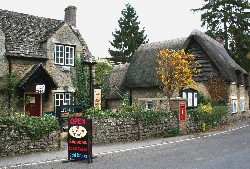 Wytham
is an attractive little village just to the west of Oxford's
Western Bypass Road, the A34, on the banks of the Seacourt
Stream. Much of the village
is owned by Oxford University and is beautifully kept
and no building is allowed that is not compatible with
the rest of the village. On
the other side of the A34 towards Wolvercote, and across
the bridge over the Seacourt Stream, is the site of Godstow
Nunnery on the banks of the River Thames. The nunnery
is now a ruin but once there was a magnificent church,
courts, cloisters and a chapter house. Close to Godstow Nunnery is
Godstow Lock. Wytham
is an attractive little village just to the west of Oxford's
Western Bypass Road, the A34, on the banks of the Seacourt
Stream. Much of the village
is owned by Oxford University and is beautifully kept
and no building is allowed that is not compatible with
the rest of the village. On
the other side of the A34 towards Wolvercote, and across
the bridge over the Seacourt Stream, is the site of Godstow
Nunnery on the banks of the River Thames. The nunnery
is now a ruin but once there was a magnificent church,
courts, cloisters and a chapter house. Close to Godstow Nunnery is
Godstow Lock.
|
|
 copy.jpg)
 Ashbury is a small, pretty, village at the foot of the
Berkshire Downs on the B4000, the road that links Lambourn,
the racehorse capital of the downs, with the Vale village
of
Ashbury is a small, pretty, village at the foot of the
Berkshire Downs on the B4000, the road that links Lambourn,
the racehorse capital of the downs, with the Vale village
of  The tiny village of Baulking
is about a mile north-east of
The tiny village of Baulking
is about a mile north-east of  Blewbury is a large spring-line village at the foot of the Berkshire Downs. The A417 skirts along the edge of the village and has some interesting and attractive houses, a small green with the remains of the village stocks, and gives a good impression of the village, but the real attractions are away from the main road. Turn down Westbrook Street, South Street, or the attractively named Nottingham Fee and you are in a different world. Look for the parish church and almshouses, the thatched cobb walls or the unexpected lake and explore the maze of footpaths.
Blewbury is a large spring-line village at the foot of the Berkshire Downs. The A417 skirts along the edge of the village and has some interesting and attractive houses, a small green with the remains of the village stocks, and gives a good impression of the village, but the real attractions are away from the main road. Turn down Westbrook Street, South Street, or the attractively named Nottingham Fee and you are in a different world. Look for the parish church and almshouses, the thatched cobb walls or the unexpected lake and explore the maze of footpaths. Buscot is an attractive little village on the A417 Faringdon
to Lechlade road about 2 miles from Lechlade, and is
the last village along this road before you cross into
Gloucestershire. Buscot village belongs to the National Trust and is a must-see if you are visiting the nearby National Trust property at Buscot Park. Stroll through the village to Buscot lock and maybe walk along the footpath to the parish church which is about a quarter of a mile from the lock.
Buscot is an attractive little village on the A417 Faringdon
to Lechlade road about 2 miles from Lechlade, and is
the last village along this road before you cross into
Gloucestershire. Buscot village belongs to the National Trust and is a must-see if you are visiting the nearby National Trust property at Buscot Park. Stroll through the village to Buscot lock and maybe walk along the footpath to the parish church which is about a quarter of a mile from the lock. Childrey is an attractive springline village nestling
at the foot of the Berkshire Downs right on the edge of
the Vale of White Horse. Approaching the village on a
fine day from Wantage about three miles away east along
the B4507, the setting appears perfect with the hills
on one side and the Vale on the other. Wonderful!
In the centre of the village is an attractive duck pond, complete with
ducks and geese, attractive cottages and the village shop
and pub.
Childrey is an attractive springline village nestling
at the foot of the Berkshire Downs right on the edge of
the Vale of White Horse. Approaching the village on a
fine day from Wantage about three miles away east along
the B4507, the setting appears perfect with the hills
on one side and the Vale on the other. Wonderful!
In the centre of the village is an attractive duck pond, complete with
ducks and geese, attractive cottages and the village shop
and pub. Goosey
is a small village about two miles south east of Stanford in the Vale
on a minor road to the east of the A417. The village consists of a few houses, cottages and
farm buildings scattered around a very large green, rather like the nearby village of Baulking. Peace and solitude!
Goosey
is a small village about two miles south east of Stanford in the Vale
on a minor road to the east of the A417. The village consists of a few houses, cottages and
farm buildings scattered around a very large green, rather like the nearby village of Baulking. Peace and solitude! Great
Coxwell is a small and unremarkable village on high ground about 2 miles south west of Faringdon, just
off the A420 Oxford to Swindon road. However just
outside the village is the
Great
Coxwell is a small and unremarkable village on high ground about 2 miles south west of Faringdon, just
off the A420 Oxford to Swindon road. However just
outside the village is the  Letcombe
Bassett is a pretty little village, arranged above a steep-sided
valley that is the source of the Letcombe Brook. Although not on the high downs,
when approaching Letcombe Bassett from
Letcombe
Bassett is a pretty little village, arranged above a steep-sided
valley that is the source of the Letcombe Brook. Although not on the high downs,
when approaching Letcombe Bassett from  Stanford
in the Vale is an attractive large village in the centre of the Vale of White Horse about four
miles from Faringdon and six from Wantage. In
the centre of the village is an attractive village green
with the Church of St. Denys on the western edge and picturesque
old cottages, the manor house and one of the village pubs
on the others. Well worth a visit!
Stanford
in the Vale is an attractive large village in the centre of the Vale of White Horse about four
miles from Faringdon and six from Wantage. In
the centre of the village is an attractive village green
with the Church of St. Denys on the western edge and picturesque
old cottages, the manor house and one of the village pubs
on the others. Well worth a visit! Sutton
Courtenay is a largish straggling village on the south
side of the River Thames about 3 miles north east of Didcot.
Sutton
Courtenay is a largish straggling village on the south
side of the River Thames about 3 miles north east of Didcot. Uffington is about a mile and a half north
of the B4507 Wantage to Ashbury road close to the villages
of Woolstone and
Uffington is about a mile and a half north
of the B4507 Wantage to Ashbury road close to the villages
of Woolstone and  t
into the hillside of the Berkshire Downs above the nearby village of
t
into the hillside of the Berkshire Downs above the nearby village of  Wytham
is an attractive little village just to the west of Oxford's
Western Bypass Road, the A34, on the banks of the Seacourt
Stream. Much of the village
is owned by Oxford University and is beautifully kept
and no building is allowed that is not compatible with
the rest of the village. On
the other side of the A34 towards Wolvercote, and across
the bridge over the Seacourt Stream, is the site of Godstow
Nunnery on the banks of the River Thames. The nunnery
is now a ruin but once there was a magnificent church,
courts, cloisters and a chapter house. Close to Godstow Nunnery is
Godstow Lock.
Wytham
is an attractive little village just to the west of Oxford's
Western Bypass Road, the A34, on the banks of the Seacourt
Stream. Much of the village
is owned by Oxford University and is beautifully kept
and no building is allowed that is not compatible with
the rest of the village. On
the other side of the A34 towards Wolvercote, and across
the bridge over the Seacourt Stream, is the site of Godstow
Nunnery on the banks of the River Thames. The nunnery
is now a ruin but once there was a magnificent church,
courts, cloisters and a chapter house. Close to Godstow Nunnery is
Godstow Lock.